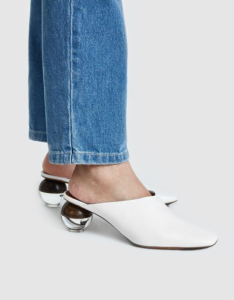
This week we have put the magnifying glass on the inner components of a shoe as part of our ongoing pursuit of high heel science…
As podiatrists we are constantly educating our patients about the important features in a shoe and how they assist in stability and overall comfort in footwear. By getting to know these components it is easier to make a good decision on what is going to be comfortable, reducing the risk of pain and injury to the foot. The same principles apply to fashion or high heel shoes – it’s all about getting to know what works best for your foot type.
The first component under the spotlight is the heel counter –

The heel counter is one of the most important features in a shoe as it provides stability to the foot and also longevity to the shoe. Without reinforced heel counters the shoe loses it shape and provides limited support to the foot. It is positioned at the back of the shoe where the heel bone sits.
A good quality heel counter is made of thermoplastic in sport shoes and either a thin plastic or treated cardboard in dress shoes. Cheaper shoes either have no heel counter or they are made of thin untreated cardboard which breaks down very quickly once the foot starts to sweat. Heel counters sit between the inner lining and the outer fabric of the upper of the shoe. Here are some points to consider when choosing footwear with or without heel counters:
- The heel counter may not suit your heel shape which increases risk of blisters. Most are heel mouldable which can be adjusted with the use of a hairdryer (use on the inside of the shoe!) or with the help of a bootmaker. Alternatively silicone products are useful in offloading pressure points around the heel. Keep your eyes peeled as we have our solution for pesky heel blisters coming your way!
- If your shoe doesn’t have a heel counter such is the case with a mule, then your foot compensates to keep the shoe on by clawing the toes. This is not great long term as the soft tissues tighten, increasing the risk of deformity.
- If the shoe doesn’t have a heel counter then try to offset this by looking for shoes that have other stability features that will assist with the overall comfort and support of the shoe, such as straps around the middle of the foot and the ankle.
Let’s compare some examples –

This shoe from Etro doesn’t have a heel counter but it does have a thick strap around the ankle and roping which will hold the foot in place. The strap placed around the midfoot is particularly helpful when trying to support the foot. The straps around this shoe may cause some friction however The Well-Heeled team have been working hard on a solution that will keep you in your favourite heels for longer. Coming soon…..

This mule doesn’t have a heel counter but it’s upper has depth and covers the foot to the midfoot which reduces the need for the toes to retract.

Take a look at these Salvatore Ferragamo (Spring 2018) boots which have a deep heel counter and a zip running up the back of the shoe. This will assist with ankle stability. And, aren’t they gorgeous!!

And lastly these Tom Ford pretties don’t have a heel counter because it is cut out. But, the ankle boot design will offset the absence with ankle stability. Very nice!
So now that you know what a heel counter is, take this into account when you purchase your next pair of shoes. If they don’t have one, then try to get some stability feature elsewhere. And don’t forget to jump onto The Shoe Equation for all your fashion shoe needs. We have heaps of offers to help you make the best choice when looking for that perfect shoe for any occasion!
Good luck and until next time,
E&E



Linda
this was very helpful as I’m learning to make shoes for myself because my feet are so wide
K.J.
I’m gonna agree with Linda previously, I was worried about the trajectory of my upper options given my design, but an understanding of the basics are giving me the options I need.
CarolynaP
my Halogen studded flats have excessive wear on the counter area. I’m trying to figure out why.